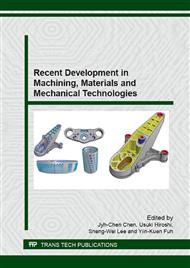p.357
p.363
p.369
p.375
p.381
p.387
p.391
p.398
p.404
Study on Ultrasonic Cavitation-Assisted Micro-Endmill Milling
Abstract:
Micro-channel chips used in micro total analysis systems are attracting attention in medicine. In generally the photolithography technology used in semiconductor manufacturing is used to manufacture micro-channel chip Si-dies. However, this technology requires many processes, such as mask fabrication and the application of photoresist to a substrate as well as expensive clean room facilities. A micro-channel chip has a micro-groove 30–100 μm wide. This study examined how to form a fine groove by cutting with a micro-endmill, with the aim of shortening the window time and reducing the cost. This steel die requires high accuracy, for example, a burr area ratio of not more than 5% of the groove bottom area, a surface roughness of the side and bottom faces of less than 1μmRz, and a change in the sectional area of less than 1%. So, this study examines micro-endmill’s cutting conditions, for example cutting speed, feed per tooth, and axial depth of cut. In MQL (minimum quantity of lubricant) cutting, the early fracture occurs when cutting was began. The cause has bad removing of the chips in MQL cutting, it is considered that the chips of hardened work have been re-cut as the result. Therefore, this study applied ultrasonic cavitation to milling, in order to solve this subject. This report experimentally examined the cutting performance of ultrasonic cavitation-assisted milling. We obtained the following results. In cutting distance of 20 m, the burr of MQL cutting is generated more than 5%, on the other hand, the burr of ultrasonic cavitation-assisted milling is less than that. In ultrasonic cavitation-assisted milling, a tool wear and fracture can be decreased by improvement of removing chips and lubrication.
Info:
Periodical:
Pages:
381-386
Citation:
Online since:
July 2015
Keywords:
Price:
Сopyright:
© 2015 Trans Tech Publications Ltd. All Rights Reserved
Share:
Citation:


